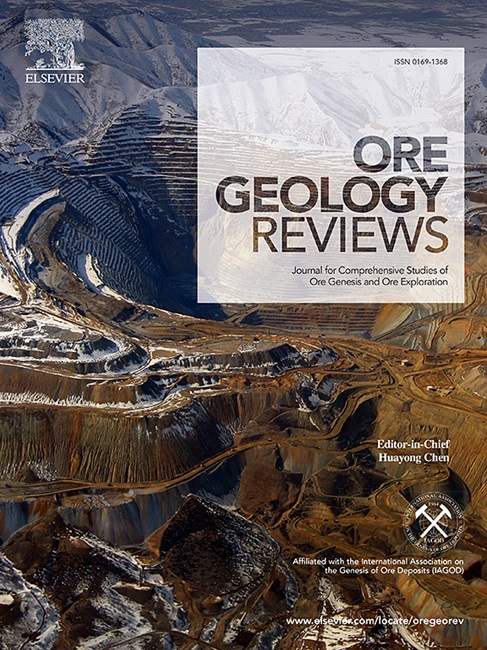Characteristics of ore-forming fluids of Li-Be deposits and its application to mineral exploration in Middle Altun Region, Xinjiang
IF 3.6
2区 地球科学
Q1 GEOLOGY
引用次数: 0
Abstract
The Middle Altun region, located at the northern edge of the Tibetan Plateau, constitutes one of China’s vital polymetallic metallogenic belts. Recent discoveries of large to medium-sized pegmatite-type Li-Be deposits, including the Tugeman, South Washixia, Shaliangxi, and Huanglongling sites, have revealed a prolific ∼ 400 km long Li-Be rare metal metallogenic belt. Current research primarily concentrates on the mineralization processes of individual deposits. This study integrates systematic sampling of ore-bearing pegmatite veins from various deposits, utilizing microthermometric analysis of fluid inclusions, laser Raman spectroscopy, and in-situ LA-ICP-MS compositional analysis of quartz in the pegmatites. The aim is to elucidate the temperature–pressure conditions, elemental enrichment characteristics, fluid evolution processes, and mechanisms of metallogenic element precipitation. The results indicate that the ore-forming fluids consist of a medium-temperature, low-salinity H2O-NaCl-CO2 system that contains sulfate, carbonate, and chrysotile minerals. LA-ICP-MS in-situ analysis of quartz suggests that the pegmatites in the Tugeman area likely originated from metamorphic-anatectic processes, while those in the West Shaliangxi region are more closely linked to highly fractionated granitic magmatism. The concentrations of elements such as Al, Li, Ti, and Ge in quartz serve as potential indicators for assessing the mineralization potential of pegmatites. Combined analyses of Ti-in-quartz thermometry and other geological evidence suggest that Li-Be mineralization in the Middle Altun region may be structurally influenced by magmatic domes. The southern Tugeman area, located at the dome’s apex, has undergone significant erosion, exposing high-temperature vein systems from the lower orebody. Conversely, the main Tugeman area exhibits limited mineralization, somewhat distal from the dome summit. In contrast, the Shaliangxi and South Washixia regions, which are situated farther from the magmatic domes, show lower degrees of erosion and well-preserved ore bodies, making them promising targets for mineral exploration.
新疆中阿尔金地区锂be矿床成矿流体特征及其在找矿中的应用
中阿尔金地区位于青藏高原北缘,是中国重要的多金属成矿带之一。近年来发现的Tugeman、南华石峡、沙梁溪、黄龙岭等大中型伟晶岩型Li-Be矿床,揭示了一条长约400 km的高产Li-Be稀有金属成矿带。目前的研究主要集中在单个矿床的成矿过程上。本研究整合了来自不同矿床的含矿伟晶岩脉的系统采样,利用流体包裹体的显微测温分析、激光拉曼光谱和伟晶岩中石英的原位LA-ICP-MS成分分析。目的是阐明温度-压力条件、元素富集特征、流体演化过程和成矿元素沉淀机制。结果表明,成矿流体为中温、低盐度H2O-NaCl-CO2体系,含硫酸盐、碳酸盐和温石棉矿物。石英原位LA-ICP-MS分析表明,Tugeman地区伟晶岩可能来源于变质-析长岩作用,而西沙溪地区的伟晶岩则与高分异的花岗质岩浆作用密切相关。石英中Al、Li、Ti、Ge等元素的浓度可作为评价伟晶岩成矿潜力的潜在指标。结合石英钛测温分析和其他地质证据,认为中阿尔金地区Li-Be矿化可能受岩浆穹窿的构造影响。位于圆顶顶端的Tugeman南部地区经历了严重的侵蚀,暴露出来自下部矿体的高温脉系统。相反,主要的Tugeman地区显示出有限的矿化,在离圆顶顶部稍远的地方。而离岩浆圆顶较远的沙良溪和南瓦石峡地区,侵蚀程度较低,矿体保存较好,是较好的找矿目标。
本文章由计算机程序翻译,如有差异,请以英文原文为准。
求助全文
约1分钟内获得全文
求助全文
来源期刊

Ore Geology Reviews
地学-地质学
CiteScore
6.50
自引率
27.30%
发文量
546
审稿时长
22.9 weeks
期刊介绍:
Ore Geology Reviews aims to familiarize all earth scientists with recent advances in a number of interconnected disciplines related to the study of, and search for, ore deposits. The reviews range from brief to longer contributions, but the journal preferentially publishes manuscripts that fill the niche between the commonly shorter journal articles and the comprehensive book coverages, and thus has a special appeal to many authors and readers.
 求助内容:
求助内容: 应助结果提醒方式:
应助结果提醒方式:


